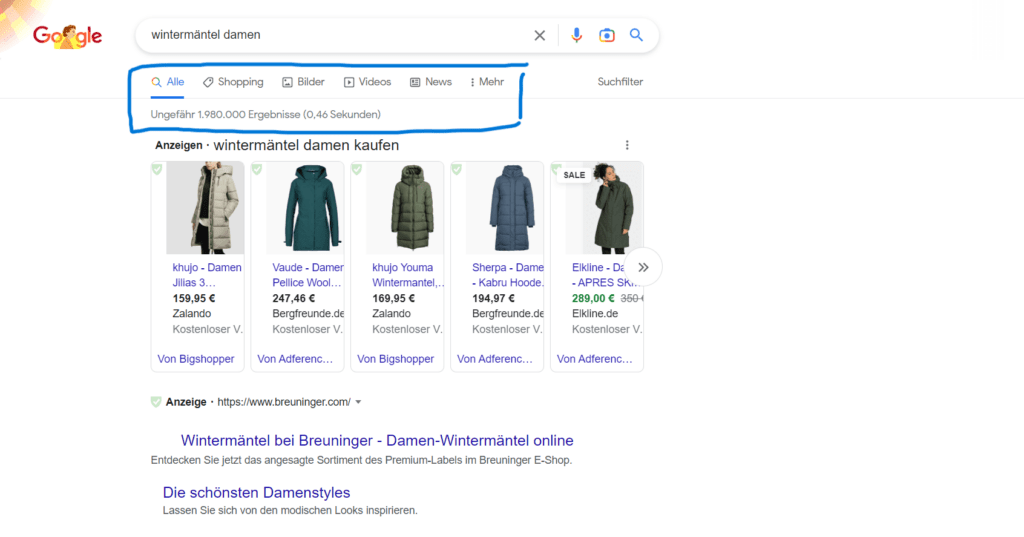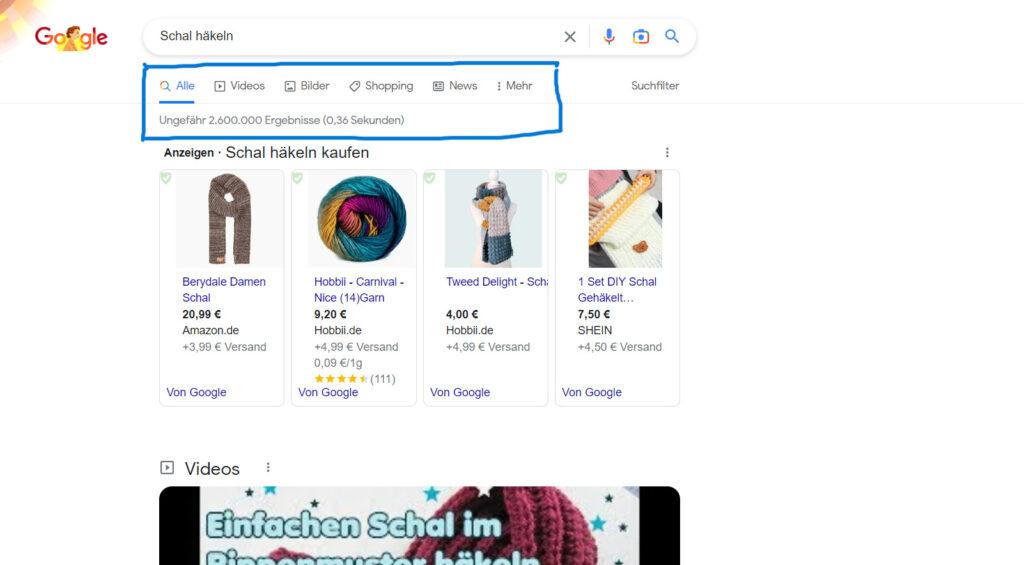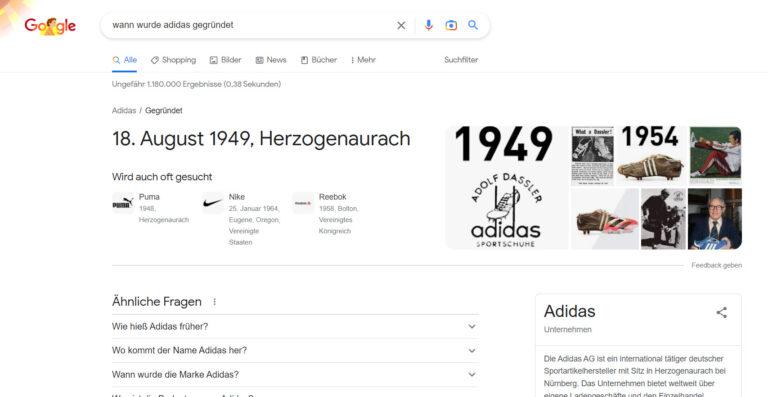Everything you need to know about your users' intentions
- Search intent is about what the user expects to find on the search engine results pages.
- While user intent describes the expectation that a searcher has of a landing page's content.
- Search & User Intent optimisation helps websites perform better in search engine results.
- There are four different types of search intent: "Do", "Know/ Know Simple", "Visit in Person" and "Website".
- Your website must offer the content your visitors are looking for.
In this article we cover the following topics:
Are you looking for an SEO partner, SEO advice or a holistic and, above all, up-to-date SEO strategy to get more traffic today and tomorrow? Then you've come to the right place. Our agency stands for sustainable, individual and transparent search engine optimisation. Together we can take your company or project to the next level. Feel free to contact us by email, phone or Whatsapp.

Was ist der Unterschied zwischen Search Intent & User Intent?
To begin with, we would like to differentiate these two terms from each other, as they are often used synonymously:
Search intent is about what the user expects to find on the search engine results pages (SERPs).
This can be pictures & videos, map entries, products, services or other types of content.
To rank successfully as such SERP, it is important that you align your content with these search expectations.
Conversely, user intent is focused on understanding what the user is looking for on the landing page (LP) in order to provide them with relevant and appropriate information, products or services.
What is User-Intent?
User Intent describes the expectation that a searcher has of the content of a landing page. The search engines evaluate the content of the hits found and assess how well they correspond to the assumed user intention. The better the information on a website matches the intention of the searcher, the better the page will be placed in Google's search results (SERPs).
For businesses that want to show up in Google search results and attract relevant visitors to their website, it is important to understand user intent. If your content meets the needs of your target audience, you are more likely to be found and rank higher in search engine results. In turn, more people will find you. The right understanding of your prospects and customers can therefore have a positive interaction.
What is Search Intent Optimisation?
Search Intent Optimisation helps websites appear prominently in search engine results. Content is often created that is not perfectly matched to the user's search query. Search Intent Optimisation ensures that the best possible result appears in response to the search query. It is about analysing why users search for certain terms, understanding what they are looking for and providing answers that meet their needs. By understanding users' motivations and providing content tailored to those needs, this process can help increase traffic and engagement on the website, improve the user experience when searching the web and achieve better conversion rates.
Die Arten der Suchanfragen & Suchabsichten
Informational, Navigational, Transactional, Local. These four types of search intent are quite well-known among SEOs and website operators. However, these terms belong to a somewhat older classification of Google on this topic. Today, we speak of the following search queries:
Do: This search query describes the intention of a concrete action. An example is "buy red Nikes". - The customer has the specific motivation to buy a certain shoe. Search results that he hopes for are, for example, online shops that offer red Nikes for sale on their landing page. But "Do" can not only mean that someone wants to buy something, this type of search query also includes the intention to download or install something.
Know/ Simple Know: This search intention describes the intention of a user to research a certain piece of information. Very popular are quick answers that searchers can find, for example, in the Featured Snippets or in the "similar questions" in the SERPs. These quick answers belong to the Simple Know category - i.e. answers for which a user does not have to call up a website. If the search intent is "Simple Now", the searcher expects a quick, uncomplicated answer. If, on the other hand, the search intent is "Know", the customer expects relevant websites that go deeper into the topic.
Visit in Person: With such a request, a user wants to find out more about a place in order to visit it in the future. This can be a holiday destination, but also a locality. The search results displayed help to find the place with the help of the keyword used. Google's own smartphone-compatible results are of course displayed particularly prominently. These can be entries on Google Maps and the like, for example.
Webseite: With a website enquiry, searchers want to find a specific page, platform or brand on the internet.

Why is user intention important for SEO?
In the past, search engine optimisation mainly revolved around the use of high search volume keywords to increase visibility and potentially generate more traffic.
Today, however, we know that users need relevant and important information for a successful customer journey. We can determine which information is important with the help of the search intention and derive the appropriate SEO measures from this. Your website must offer the content that your visitors are actually looking for. If this is the case, the Google algorithm recognises this and the search engine will classify your website as more relevant and rank it higher in the search results. This is also advantageous from the users' point of view, because they are usually much more satisfied when they find results that are relevant to their search query. This relevance to the users' needs leads to better click rates, more traffic, a longer stay on the page and better conversions.
How does User Intent influence keyword research?
When users search for information online, they almost always have a specific intention - whether it is to buy something, find a specific website or try a new recipe. If you want your website to rank among the top search results, it's important to consider your prospects' intent when doing keyword research. If you carefully analyse the keywords used by specific demographic groups or target audiences - what phrases, terms and words do they use most often? What is the location of most visitors, what is the average age - you can draw conclusions about their search behaviour & intentions and ensure that your content and strategy is relevant and valuable to your users. In this way, you not only promote the interaction of your interested parties with your site, but also achieve your goal: a good ranking in the search engine results.
User intent in the customer journey
Over time, a user changes his or her search intention with regard to his or her customer journey. Put simply, people are usually looking for a solution to a problem first. These queries are often more "website" or "know" oriented. Once a search result or web page has piqued their curiosity, they move on to a more detailed query and search with more specific keywords and move on to a more "Do" oriented search. Once they are convinced of the merits of a product or service, they then decide to buy. But then the customer journey is not over.
After the customer has bought the desired product, it is also important that helpful information about the application, accessories and similar products is offered. This promotes customer retention and loyalty. This way, the customer will recommend your products or your brand to others and will not forget you.
What can the duration of time spent on the site tell us about Search Intent?
Dwell time, as described by Google Analytics, is a measure of the engagement of your visitors on a particular landing page of your website. A longer dwell time usually indicates that visitors find the content useful or engaging.
However, a short dwell time does not always mean that the desired information was not found. In some cases, e.g. a request for contact information, this can lead to a quick resolution, which usually results in no or only a very short dwell time being displayed. Google Analytics then records this as a "bounce" instead. However, there is the following solution: Assign an action to your form in order to be able to track it precisely. This way you can check whether your visitors leave your site satisfied or dissatisfied.

Search Intent Optimisation: three key questions
Search intent is the most important factor that determines how users interact with search engine results. If you understand this crucial element of user behaviour, you can tailor the content exactly to the needs of the target group. Once you have understood the behaviour of your users, you can address them better and thus achieve a good organic position as well as a higher conversion rate in the purchase phase.
As already noted, your prospects go through a customer journey in which the search intention changes. Most of the time, users start with an information-oriented or website-oriented enquiry and then move on to a transactional "do" or commercial enquiry, such as "buy now". Accompany them on their journey accordingly.
Question 1: Do I have the right content for my keywords?
Your keywords should match your content - that means the content of your landing page should match the expectations that a keyword triggers. An example: Enter the term "winter coats ladies" in the Google search. You will see that on the first search results page you will almost exclusively find online shops such as Zalando or About You or category pages of shops. If, on the other hand, you search for crochet scarf, you will find numerous video tutorials and blog posts that explain step by step what to do.
These results are due to the Google algorithm. It can be seen that certain keywords or keyword combinations go hand in hand with a certain search intent. So you will not be able to rank with the keyword "winter coats ladies" with a blog article and with the keyword "crochet scarf" not with a category page of your online shop.
This is especially important if you want to optimise a page for a specific keyword. Take some time to look at the terms associated with your keyword and check which results are displayed in the search engines in this context. This way you can make sure that you are optimising specifically for that term or search query and that you are hitting the intent of your visitors.
An important element that can help you check your keywords is the order of the search filters under the search bar:

If "shopping" is in first place directly after "all", you recognise the primary search intent of the keyword "winter coats ladies". The difference to the keyword "crochet scarf" is clear:

The intent here is not "Do", but rather "Know". Searchers prefer video content to learn how to crochet a scarf.
Question 2: Do I have a realistic chance of getting clicks?
You should ask yourself this question if you want to optimise your content for a search query that belongs to the search intent "Know Simple". This search intent is also one of the so-called "no-click searches" and means that the answer to a question is already found in the search results, so that the person searching does not have to click on a specific website link.
An example: You have an online shop and sell Adidas clothes and shoes, but you don't rank very well for this brand yet, so the clicks still leave a lot to be desired. You think about how you can optimise your page and decide to write a blog post on the topic "When was Adidas founded". After the first user intent research, however, it turns out that this topic belongs to the category "Know Simple":

This topic is therefore one of the "no-click searches" and is very likely to get little or no traffic, even if you achieve a very good ranking. In addition, with this and many similar queries, you have to deal with strong competition, such as Wikipedia and, in this case, Adidas.
Conclusion: Weigh up whether the search term you want to rank for has a realistic chance of getting clicks & research your topic beforehand to see what the intention is!
Question 3: What ranking options do I have?
As already noted, you can tell a lot from search results, including SERP features. These are elements such as videos, images, questions and of course pages that appear in the Search Engine Result Pages (SERPs for short).
If you look at these results, you can see which search intent is preferred by the search engine algorithms for the respective keyword. Here are a few examples:
Videos: Videos hosted e.g. on YouTube or other websites
Images: Optimising images for Google Image Search. You can find out how in this article: Images SEO of the future: Visual Search & Google Lens
Local search: Local listings (via Google My Business) that optimise with Local SEO
Headlines: News that shows up in Google News
Unfortunately, these alternatives are not always practical or beneficial. In particular, optimising for Google News can prove expensive and ineffective, as the articles published here only have a short lifespan. The creation of videos can also be associated with considerable costs. Theoretically, however, it is possible to be visible in different areas of the search results at the same time, e.g. in the organic search results, the image search and the video search. Ultimately, each company must decide for itself how far it wants to go in optimising for search and user intention.
Image sources:
- Glenn Carstens-Peters/unsplash.com
- Solen Feyissa/unsplash.com
- 123rf.com/profile_marchmeena
- Screenshots Google Suche
About the author: Louisa Anger

Louisa specialises in writing search engine optimised texts and articles in the online marketing field. She researches and writes SEO-optimised content for various companies from different industries. At SEO-Suchhund, Louisa is the person responsible for the topic of SEO content.
